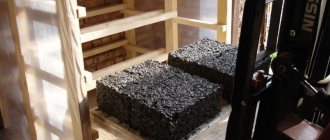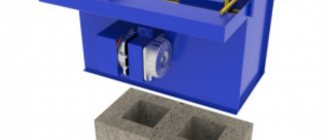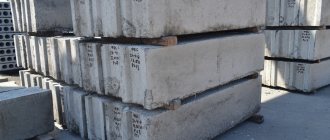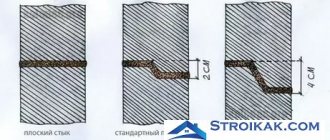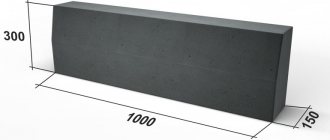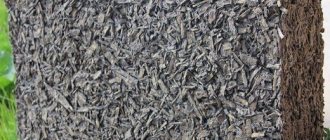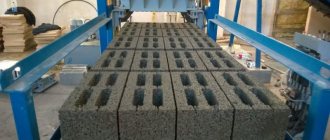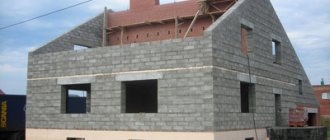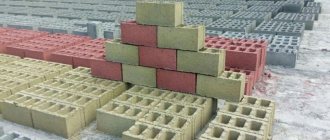Making building materials at home has certain features.
Aerated concrete blocks can only be made independently using a non-autoclave method, by pouring a concrete solution with blowing agents and plasticizers into prepared removable forms.
To do this, you can use mobile or mini lines, as well as the manual method. How to properly create a gas block with your own hands, and what you need for this, read in the material presented.
U-shaped aerated concrete blocks: the best method to arrange
Ordinary concrete lintels produced by factories often cannot be used for buildings that have unique openings and unusual shapes. Apart from this, another problem arises - the high cost of the costs and jumpers for transporting bulky products.
Aerated concrete lintels are free from all these shortcomings. They can be prefabricated or prefabricated-monolithic.
Application area
Construction of low-rise buildings (up to 3 floors). Construction of load-bearing, internal and external walls. During monolithic frame construction of external walls, aeroc aerated concrete blocks fill them.
Advantages, characteristics and purpose of blocks
Trough and aerated concrete blocks can play the role of formwork, and allow you to create prefabricated or prefabricated monolithic lintels.
METHOD for making U-BLOCKS with your own hands
Rectangular
They are a smooth rectangular parallelepiped. Density D500. Used for any type of installation. They are laid using cement, a warm adhesive composition with a seam width of about 11 cm.
Geometry
The geometric accuracy of aerated concrete is the highest, the error is small - 0.1 cm. The precise geometry of aerated concrete allows the use of an adhesive composition with the lowest consumption. The seams do not require additional adjustment.
U-Block Dimensions
This abundance allows you to assemble an impeccable “constructor” with ideal connections in all planes.
Pros and cons of producing aerated concrete at home
The advantages of creating gas blocks with your own hands are the following:
- Low costs for purchasing materials. Tools and equipment can always be rented for the required period.
- Flexible work schedule and independence from suppliers.
- Creation of an environmentally friendly block of the desired shape, density and strength, in accordance with the plan.
- Independent control over the work process.
The disadvantages of own production are:
- It is time-consuming, so you will need to be personally present from the beginning of the process to the end.
- Labor intensive - you need to do everything yourself (purchase of materials, preparation, mixing the solution, temperature control, laying out the pour, loading finished products).
Non-autoclave blocks will be less durable than professional autoclave ones , but they will have material characteristics no worse than those made on an industrial belt, differing only in strength (for conveyor ones it is much higher).
Nuances of the format, specifics of working with material of a special configuration
There is no building material without flaws, and even a seemingly flawless product can conceal a hidden flaw within itself. A categorical list of weak points cannot be attributed to U-shaped blocks; rather, these will be aspects of selection and work with the material:
- overhead compared to a standard wall element;
- the need for individual purchases;
- lack of product during the “high” construction season;
- higher thermal conductivity compared to wall material.
U-BLOCK WITH YOUR OWN HANDS (QUICK AND EASY)
Correct casting of the mixture
Mix all the ingredients with water and stir until the desired consistency, then pour into the mold and compact.
After a couple of days, the block can be removed from the mold and sent to dry for a month. The price will be approximately 22.5 rubles per piece, since a regular block of 15-18 kilograms will consume 1-2, 4 and 10-11 kilograms of cement, sand and expanded clay, respectively.
Complex configuration without sacrificing versatility
The U-shaped aerated concrete block is multifunctional in its own application. They can be used as permanent formwork in the manufacture of reinforced lintels and the construction of stiffeners for the following purposes:
- Construction of lintels over door and window openings.
- Construction of a one-piece stiffening belt:
- pouring supports for mauerlats and rafters;
- base for supporting precast concrete slabs.
- Creation of other lintels of prefabricated or prefabricated monolithic type.
Do-it-yourself U-block - manufacturing methods
Forming a classic ordinary block
This will require a lot of effort and the presence of a special tool. The sequence of actions is as follows:
For example, you can increase the width of the outer wall to improve thermal conductivity.
Making such a block on your own demonstrates the following:
When using this option, material loss cannot be avoided. Also, working with fragile gas silicate will require a skill that will still have to be developed.
Assembling a U-shape from several blocks of varying thicknesses
The operating principle is also simple and can be implemented with minimal physical and monetary costs. This is a local laying of the walls of the future element using small thickness blocks, calculated based on the width of the wall, on glue. Take a look at the proposed diagram:
So, for example, to make U-shaped blocks with a thickness of 375 mm, conventional blocks with a thickness of 150 mm, 75 mm and 50 mm will be required. Assembly takes place locally in the following order:
- First, on the outside of the wall, we lay 150 mm thick blocks on glue in the usual way.
- Next, we saw off the 75 mm thick blocks to a height of 175 mm and mount them lying down on glue. This will be the bottom of the U-shaped block. One side of this block is glued to the lower block . The other side is to a block 150 mm thick.
- Now we need to glue 50 mm thick blocks on the inside of the wall.
When the glue sets, we will get a durable structure that is not inferior in strength to the original U-blocks.
The main advantage of such a replacement is the speed and ease of manufacture, because it will be enough to make only 1 cut using a hacksaw on aerated concrete without subsequent molding. And assemble the structure with glue. In general, the use of a U-block in aerated concrete construction is relevant and justified. This form is applicable both for the manufacture of enclosing structures and for use as permanent formwork. And the ideal connection to all used elements minimizes the presence of cold bridges in the house, which means it guarantees the construction of a warm and comfortable house.
Nuances of the format, specifics of working with material of a special configuration
There is no building material without flaws, and even a seemingly perfect product can harbor hidden flaws. A categorical list of weak points cannot be attributed to U-shaped blocks; rather, these will be the nuances of choosing and working with the material:
- high cost compared to a standard wall element;
- the need for individual purchases;
- shortage of product during the “high” construction season;
- higher thermal conductivity compared to wall material.
Advantages and disadvantages
how to make a block from aerated concrete with our own hands. Now let's look at the advantages of this material:
- ease of installation work. The low specific weight of the blocks and good strength indicators allow you to save money without using special lifting equipment. Aerated concrete lintels can be made manually;
- exact geometric parameters. Various types of blocks are used taking into account the required wall thickness. The width of aerated concrete u-blocks is equal to that of a standard stone;
- load-bearing structures and built-in elements are homogeneous. The material used to build walls and fill lintels is the same. This circumstance speeds up and facilitates the finishing work process;
- blocks are a material that perfectly retains thermal energy.
READ DIY bathroom countertop
It should be added that the material is considered environmentally friendly, resists temperature fluctuations and exposure to open flames, and has a long service life.
In addition to these positive qualities, there are also negative aspects:
- When pouring a lintel at a construction site, you must wait at least four weeks for the concrete to gain strength. Only after this do they proceed to installation work;
- if the stone is made using a non-autoclave method, it will be difficult to prepare a u-shaped element from it due to its fragility.
Algorithm for producing and purchasing blocks
- mix cement material, river sand and quicklime in certain proportions;
- add water, add aluminum powder;
- the resulting composition is laid out in forms;
- during gas formation, the raw material increases in volume;
- finished products are sent to an autoclave unit, where they are processed under high pressure and temperature conditions;
- The products are removed from the molds, placed on pallets and covered with plastic film.
Convenience lies in the fact that the block can be laid on any side.
This production process is possible only in factory conditions, when there is the necessary equipment and quality control of each working stage.
When purchasing blocks you should pay attention to certain points:
- shade of stone. Products must be white. This means that it was made using an autoclave method. If the block is gray, it means it was poured directly at the construction site;
- documents confirming quality. With their help, you can make sure that you are offered good material. Unforeseen difficulties will never arise when working with him.
Materials, tools, equipment
In order for the production of an aerated concrete block to be carried out efficiently, it is necessary to prepare building materials to create a high-quality mixture, tools and equipment. Regardless of how the process of creating an industrial product takes place - on an industrial tape or at home, the general technological requirements for the composition are the same for any type of aerated concrete production , in accordance with regulatory rules:
- GOST 21520-89;
- GOST 25485-89;
- SN 277-80.
A mixture of concrete with gas formers and plasticizers is made from such materials:
- cement M400, M500;
- clean running water;
- quartz sand;
- quicklime;
- aluminum soda (powder, paste);
- caustic soda;
- gypsum additives;
- expanded clay;
- sodium sulfate.
To manually make products in the utility room, you will need the following tools:
- solution container;
- construction mixer;
- shovel;
- trowel;
- manual rammer;
- team uniform.
Sometimes, to speed up the process, mobile installations are used in home production. These types of equipment are fully equipped. They can be rented for the period necessary to produce the required quantity of aerated concrete products. Advertisements for the rental of mobile installations from individuals or construction companies are available on social platforms on the Internet.
Important ! Professional equipment (conveyor, stationary) includes a conveyor belt, dispensers, distributors, automation units, an autoclave, crushers, molds, vibrating screens, carts, etc. A complete set of mechanisms is sold by companies of domestic and foreign production, and contains markings, instructions, a quality certificate and a guarantee.
how to lay gas blocks with your own hands
Modern houses are increasingly being built using new technologies, which are displacing traditional brick cottages. SuperDom will talk about the nuances of building from aerated concrete blocks and how to properly lay aerated concrete with your own hands.
Forming a classic ordinary block
This will require a lot of effort and special tools. The sequence of actions is as follows:
- marking according to the required dimensions, based on the thickness of the wall;
- making 2 main cuts that determine the wall thickness;
- making several auxiliary cuts or drillings for ease of processing;
- removing the inner part using a mason's hammer and final shaping it.
This method allows you to make an element with any required parameters yourself.
For example, you can increase the width of the outer wall to improve thermal conductivity.
Making such a block on your own demonstrates the following:
Using a power tool for cutting aerated concrete significantly speeds up the process:
When using this option, material loss cannot be avoided. Also, working with fragile gas silicate will require a skill that will still have to be developed.
Features of installing u-blocks
When laying, a special adhesive composition is used. The structure is reinforced with metal rods located inside the gutter part and filled with concrete. The grade of concrete mortar and the size of the rods are determined by the magnitude of the effective load. The cavity of the block is filled to the top edge.
Advantages and disadvantages
Despite its non-standard shape, the U-gas block has many advantages. Among them are:
- Improved strength properties and long service life. These indicators are achieved through autoclave processing.
- Light weight. The advantage is due to the presence of hundreds of thousands of cells throughout the structure.
- Resistant to fire and no problem of release of toxic substances when exposed to extreme temperatures.
- Excellent thermal insulation properties. They are provided by the cellular structure of the material.
- Compliance with all environmental safety standards. The blocks contain safe components of natural origin. These include: water, cement, lime and sand.
Due to many advantages, such products occupy leading positions in the list of the most popular building materials.
In addition to the advantages, the designs also have disadvantages. First of all, walls made of U-shaped aerated blocks require double primer treatment, since such a mixture does not adhere well to the surface. In this case, it is impossible to use simple plaster for finishing, because... it will fall off quickly. It is replaced with a deep penetration primer.
The material cannot provide a good degree of fixation of fasteners. Condensation can accumulate in the porous structure, which leads to the appearance of cracks and deformations.
When fixing household appliances (TVs and air conditioners), various difficulties may arise, which is due to the specific shape and structure of the material.
If the basic rules were not followed during the production of stone, it will be problematic to create high-quality material based on it.
READ DIY sauna stove
Assembling a u-shape from several blocks of different thicknesses
Unlike the previous method, assembling Y-shaped blocks from several structures requires less physical effort and monetary costs. Builders just need to lay out blocks with a small thickness along the marked perimeter, guided by some principles and recommendations.
- Blocks 150 mm thick are fixed on the outside using an adhesive base.
- After this, structures with a thickness of 75 mm are fixed. They need to be sawn off to a height of 175 mm and secured in a lying position with an adhesive compound. This is necessary to create the bottom of the U-shaped structure.
- At the end, it remains to fix the products at 50 mm.
After the glue has set, the strength properties of the structure will be increased to the factory level.
The key advantages of the method are accessibility and ease of production, since builders need to make 1 cut with a hacksaw on aerated concrete, but do not resort to molding measures.
Specifications and Dimensions
Modern U-shaped blocks that are available on the market have one length, regardless of size. Their structure provides for the presence of a longitudinal cavity. Outwardly, they resemble a tray, where one wall has a slight thickening for fastening from the outside.
There are some standards by which product sizes are determined.
Like jumpers
If it is necessary to construct a lintel using gas silicate blocks, you can use one of two methods:
- Fix the block horizontally and fill it with concrete. After the solution has hardened, the jumper must be lifted to its original place using special equipment.
- U-shaped blocks of aerated concrete can be placed in timber formwork secured over the opening. To strengthen the structure, metal reinforcement is used, which is filled with concrete mixture. After achieving the required strength properties, the formwork is dismantled.
When carrying out work, it is necessary to ensure that the base where the jumper is poured is placed correctly.
Forming a classic ordinary block
The first option requires some effort and skill. You will also need to prepare a professional tool, draw up drawings and follow the sequence of actions:
- First of all, it is worth applying markings, taking into account the size and thickness of the wall.
- Next, 2 key cuts are made, on which the thickness of the walls will depend.
- At the next stage, you can make auxiliary cuts or holes for more convenient processing of the structure.
- Finally, the inside of the block is removed using a mason's hammer and the final shaping step is carried out.
The disadvantages of this option include high material costs. Processing fragile gas silicate also requires some skills.
Armopoyas
U-blocks made of aerated concrete have found their application in the construction of attic floors. They allow you to remove the load from floor slabs or attics from load-bearing walls.
- The blocks are fixed with glue or cement mixture. In this case, it is necessary to glue the joints and ensure the evenness of the surface.
- To construct a reinforcing frame, steel rods should be used and secured longitudinally with knitting wire.
- After this, you can proceed to laying the frame base into the gutter cavity. The main part of the rods should be placed at the bottom of the frame.
- Spacers are used to secure the frame. The inner walls need to be moistened.
- Next, the structure is poured with concrete, followed by removal of air bubbles.
- The surface is aligned to the level of the block plane.
Application area
The scope of application of this building material is quite extensive. On its basis, durable formwork is erected, lintels are prepared in the openings, armored belts and supports for attaching the rafter system are equipped.
In cross-section, the block looks like a kind of tray. After fixing the rods in the niche of the gutter, the concrete solution is poured. As it hardens, the strength properties of the structure increase.
Power belts are effective in uniformly distributing loads on openings and walls. A properly arranged belt gives the room additional rigidity.
U-shaped blocks made of aerated concrete also allow you to construct stationary formwork or create roof support elements.
Features of storing cinder blocks
Often, cinder blocks are stacked in pyramidal stacks of 100 pieces, leaving a small distance between them.
After about a couple of months, when they harden, they can be used to build a house, bathhouse or barn.
How to make it yourself
Often craftsmen create u-shaped aerated concrete blocks with their own hands. This allows you not only to reduce costs, but also to gain useful experience that will be useful in future construction work. There are two options for manufacturing such structures: the formation of a classic ordinary block and the assembly of aerated concrete U-blocks from several elements.
Sources:
https://sitysun.ru/raznoe/u-bloki-iz-gazobetona-uu-bloki-gazobeton-svoimi-rukami-razmery.html https://izbloka.com/dom/steny/bloki/gazobeton/u-bloki .html https://mount-blade.ru/raznoe/kak-sdelat-u-blok-iz-gazobetona-svoimi-rukami-uu-bloki-gazobeton-svoimi-rukami-razmery-razmery-i-sposoby-izgotovleniya- svoimi-rukami.html https://1beton.info/izdeliya/peremichki/u-bloki-gazobeton
